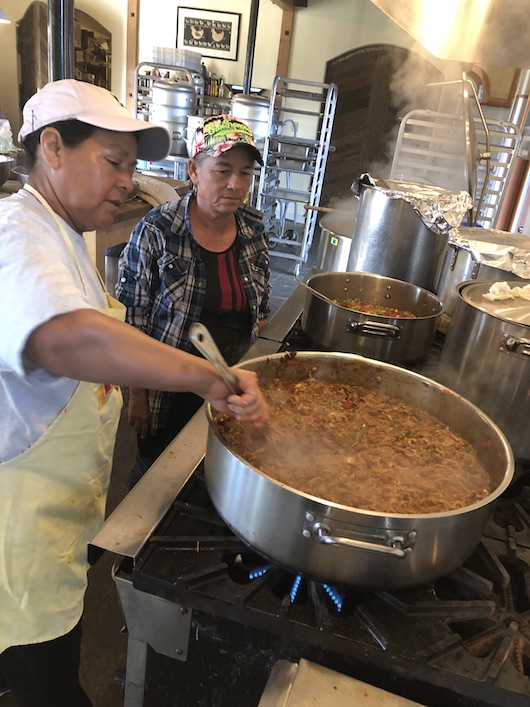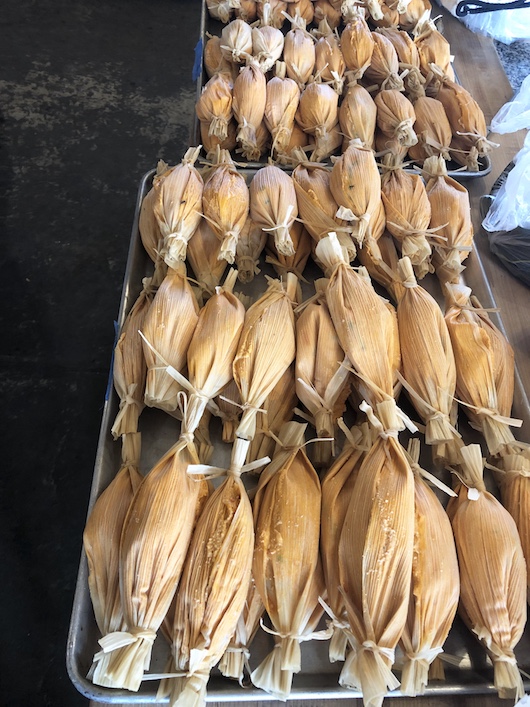
For the past thirty-one years, there is one particular autumnal day where Full Belly Farm is magically transformed into a bustling festival. That festival is what we lovingly call, The Hoes Down Harvest Festival. It is a time to throw down our hoes from our hard summer of work, and kick our heels up in celebration!
If you’re reading this, chances are that you already know about Hoes Down. You’ve tasted the heirlooms, visited the marketplace, sat-in on workshops, and camped beneath the trees in the walnut orchard. But do you know how it all comes together?
One major component to the success of the Hoes Down Festival (and any true celebration if you ask me!) is the delicious food. The majority of the food is made on-site, either prepared prior to the Festival, or by phenomenal volunteers that help us to keep all our attendees fed. Within each food booth at the event there is great variety to choose from. On Wednesday of this past week we prepared one of the key delicious treats: tamales! But more specifically, 1,200 tamales!
First of all, lets talk about the ingredients. Two hundred pounds of masa that is mixed for us at El Toro Market in Esparto, twenty-two chickens that are donated either from Flea Street Cafe in Menlo Park or our own, thirty pounds of cheese, and not to be forgotten, roughly one-hundred pounds of vegetables from our farm and others. Though the quantity alone is jaw dropping, putting the ingredients together is the truly magical part.

For years, the women of our field and flower crew have led Tamale Day. This is a day where these women share a talent of theirs that is typically not put to use on the farm. The morning of Tamale Day, Haley and I were running around collecting various necessities around the farm and when we arrived back in the kitchen, about thirty minutes later, everyone else had already arrived. Lo and behold, while we were away they created a booming tamale factory! Yessie mixing the cooked red chiles into the masa by hand (each batch weighing roughly fifty pounds); Maria and Fidi cooking the red sauce to season the chicken, asking each other for feedback on flavor and what was missing; Chica soaking the corn husks and preparing the workstation; and others moving around the kitchen in preparation. In all, eleven women were in motion, helping and sharing with one another.

Soon we made a production line: first, coat the corn husk with masa; second, place the filling inside and fold it closed; third, tie the tamale closed using ripped pieces of corn husk. Once filled and tied, the tamale is placed in a steaming basket with sixty-five other tamales and steamed for roughly two hours. As the production line formed, and everyone was nestled into position, the busy energy eased, and the humming chit chat began. I looked around and finally got to know my coworkers in a more intimate way. Without them this farm would just be a big patch of dirt.

We got to talk about family and cooking. I’m still learning Spanish, so Chica would slow down sometimes so that I could understand the jokes and gossip that was being passed around the table. She made a point to include me and I appreciated it. As we lathered corn husks, and talked about dishes our mothers made for us, I couldn’t help but think about the great amount of knowledge and love for food that all of these women have. How they hold this awesome, tangible knowledge surrounding the plants that we grow, and also the labor intensive process of harvesting and cooking them. I spent the whole day bonding and being instructed by this amazing group of Latina women who hold so much knowledge. In the moment it was humbling and I felt lucky to be included and brought into this group. I can’t help but think about what would change in this world if more people had a day like mine. A day where they came together with others who seem different on the surface and have different life experiences, but have the same joy for shared work, shared meals and shared experiences.

By three o’clock we completed 1200 tamales! An hour before the work day was even over! I’ve never been a part of Tamale Day before, but it was such a wonderful example of the teamwork and community that is involved in preparing for the Hoes Down, so I felt compelled to share it with you. Although I don’t know all of you and am pretty new to the Farm, Tamale Day was a great example of knowledge and passion that not only runs this farm, but also helps to build an amazing harvest festival too.
Sierra Reading
Educational Programs
